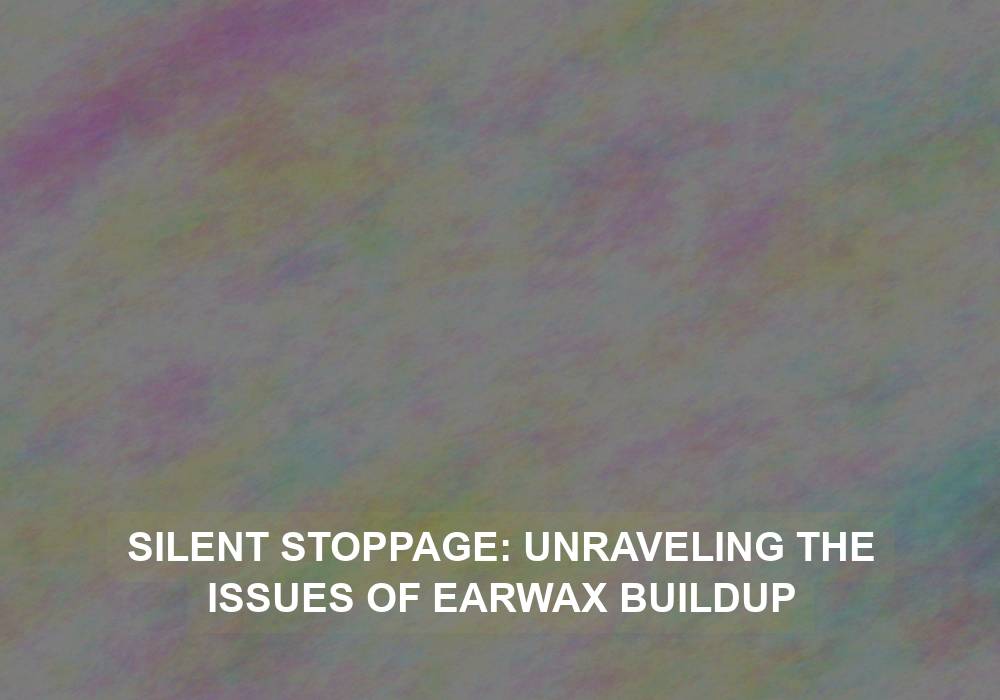Earwax buildup, also known as cerumen impaction, is a common problem that affects many individuals worldwide. While it may seem like a trivial issue, excessive earwax can lead to a range of symptoms and complications if left untreated. This article aims to shed light on the causes, symptoms, and treatment options available for earwax buildup.
The Role of Earwax
Before delving into the details of earwax buildup, it is essential to understand the purpose of earwax in our ears. Earwax, scientifically known as cerumen, is a natural substance produced by the ear glands. It serves as a protective barrier, preventing dust, debris, and harmful microorganisms from entering the ear canal. Additionally, earwax helps to lubricate the ear canal, preventing dryness and itchiness.
Earwax buildup occurs when there is an excessive production of earwax or when the earwax is not effectively removed through natural processes. When this happens, the earwax can become impacted, leading to a range of symptoms and potential complications.
Understanding Earwax Buildup
Earwax buildup can occur due to various reasons. Some individuals naturally produce more earwax than others, which can increase the risk of buildup. Additionally, individuals with naturally narrow ear canals are more prone to earwax buildup as there is less space for the wax to exit the ear. Moreover, improper ear hygiene practices, such as inserting cotton swabs or other objects into the ear canal, can push the wax deeper and contribute to impaction. Regular use of hearing aids or earplugs can also push the earwax deeper into the ear canal, leading to buildup. Furthermore, certain skin conditions, such as eczema or psoriasis, can affect the health of the ear canal, increasing the likelihood of earwax accumulation.
Common Causes of Earwax Buildup
Several factors contribute to the development of earwax buildup. These include:
- Narrow Ear Canal: Individuals with naturally narrow ear canals are more prone to earwax buildup as there is less space for the wax to exit the ear. This can lead to an increased risk of impaction.
- Excessive Earwax Production: Some individuals naturally produce more earwax than others, leading to an increased risk of buildup. This can be influenced by factors such as genetics or hormonal changes.
- Improper Ear Hygiene: Inserting cotton swabs or other objects into the ear canal can push the wax deeper, leading to impaction. It is important to note that the ear is self-cleaning and inserting objects can disrupt this natural process.
- Use of Hearing Aids or Earplugs: Regular use of hearing aids or earplugs can push the earwax deeper into the ear canal, contributing to buildup. It is important to clean hearing aids regularly and follow proper hygiene practices.
- Skin Conditions: Certain skin conditions, such as eczema or psoriasis, can affect the ear canal’s health, leading to an increased likelihood of earwax accumulation. Managing these skin conditions can help prevent excessive earwax production.
Symptoms and Complications
When earwax buildup occurs, it can result in various symptoms that may vary from person to person. Some common signs of earwax impaction include:
- Earache: A persistent or throbbing pain in the ear.
- Hearing Loss: Partial or complete hearing loss, often described as muffled sounds.
- Tinnitus: A ringing, buzzing, or hissing sound in the ear.
- Dizziness: A feeling of imbalance or vertigo.
- Itchiness: Uncomfortable itching sensation in the ear canal.
- Ear Infections: Earwax buildup can create a suitable environment for bacterial or fungal infections.
If left untreated, earwax buildup can lead to complications such as:
- Impacted Earwax: Severe impaction can result in a complete blockage of the ear canal, causing significant discomfort and hearing loss. It is important to seek medical attention if you experience severe symptoms or have difficulty hearing.
- Eardrum Damage: Forceful attempts to remove earwax can potentially damage the delicate eardrum, leading to pain and hearing problems. It is essential to avoid inserting objects into the ear canal and to seek professional help for earwax removal.
- Middle Ear Infections: Prolonged earwax impaction can increase the risk of middle ear infections, which can be painful and require medical intervention. Prompt treatment is necessary to prevent complications.
Treatment Options
Fortunately, several treatment options are available to address earwax buildup and its associated symptoms. It is important to note that self-treatment methods should be approached with caution to avoid any potential harm. It is always advisable to consult a healthcare professional for proper diagnosis and guidance. Some treatment options include:
- Earwax Softeners: Over-the-counter earwax softeners, such as cerumenolytic drops, can help soften the wax, making it easier to remove. These drops can be applied according to the instructions provided.
- Irrigation: Healthcare professionals may perform ear irrigation using warm water or saline solution to gently flush out the impacted earwax. This procedure should be done by a trained professional to avoid complications.
- Manual Removal: In cases of severe impaction, a healthcare professional may manually remove the earwax using specialized instruments under visual guidance. This procedure should never be attempted at home.
- Microsuction: This procedure involves using a suction device to safely remove the earwax, especially when the eardrum is fragile or damaged. It should be performed by a trained professional.
- Preventive Measures: Adopting proper ear hygiene practices can help prevent earwax buildup. This includes avoiding the use of cotton swabs or other objects in the ear canal, as well as regularly cleaning the outer ear with a washcloth. It is important to consult a healthcare professional for personalized advice.
Summing Up
In conclusion, earwax buildup is a common issue that can cause a range of symptoms and potential complications if not addressed promptly. Understanding the causes, symptoms, and treatment options available is crucial for managing earwax buildup effectively. Remember, seeking professional advice is essential to ensure safe and appropriate care for your ears. By taking proper care of your ears and seeking timely treatment, you can prevent the silent stoppage caused by earwax buildup and maintain optimal ear health.
